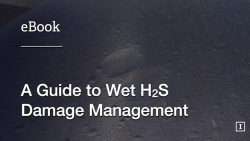Sponsored by ![]()
Overview
Wet hydrogen sulfide (H2S) damage is a common problem in the oil and gas industry that can occur when carbon and low-allow steel is exposed to aqueous phase process environments containing sulfur and specifically, hydrogen sulfide. Wet H2S damage can detrimentally affect the load-carrying capacity of pressure equipment and can manifest itself in numerous forms of material degradation, including hydrogen blistering, hydrogen induced cracking (HIC), stress-oriented hydrogen induced cracking (SOHIC), and sulfide stress cracking (SSC). Wet H2S damage is complex and often misunderstood because the overall propensity for these damage mechanisms is governed by different controlling metallurgical and environmental variables. Furthermore, each form of wet H2S damage exhibits distinctive morphologies, introduces varying levels of risk, and ultimately can promote different failure modes. Damage propagation rates can also be difficult to predict and can be accelerated by minor changes in process environments.
It is believed that some of the first industry experiences with different forms of wet H2S damage occurred in the 1950s in both the U.S. and Canadian oil fields. Yet, even today, wet H2S damage continues to afflict pressure vessels, piping, and other types of process equipment in the oil and gas, mining, power generation, and related industries. Understanding the different types of wet H2S damage, identifying which process units and equipment are most prone to such damage, and establishing appropriate inspection plans for in-service equipment can mitigate costly unplanned outages and equipment failures.
This short eBook summarizes the fundamentals of wet H2S-related damage mechanisms, discusses operating conditions and other factors influencing damage progression, and presents the typical damage characteristics and morphologies of each mechanism. Additionally, it will offer some practical inspection guidance and discuss common locations predisposed to wet H2S damage on typical pressure equipment. This eBook also discusses how to assess the different forms of wet H2S damage using modern fitness-for-service and computational analysis techniques, as well as outlines practical steps to mitigate the often complex, yet unique forms of wet H2S damage.
Log in or register below to download this free guide to Wet H2S Damage Management.















